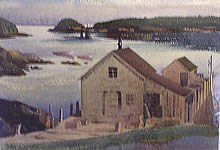BIOGRAPHY

SANDOR BERNATH
(1892-1985?)
Sandor Bernath was born in Hungary on December 30th, 1892, far removed from the New England coast and the Yankee sailing ships that would become his favorite subjects. He immigrated to New York either in his teens or early twenties, and began there a career in watercolor that flared with the urban lights of the Jazz Age before dissipating into the pastoral and, eventually, the unknown.
In the landmark exhibition catalogue, Sandor Bernath: Watercolors, issued by the Smith Gallery of New York, Jennifer Krasinski suggests that Bernath’s January, 1922 solo exhibition at Mrs. Malcolm’s Gallery on East 64th Street served as the artist’s mainstream debut. In fact, he had exhibited prominently before, displaying In a Studio at the 52nd Annual Exhibition (1919) of the American Water Color Society, Late Afternoon at the 54th Exhibition (1921), and Down Town Through Bridge the following December at the inaugural combined exhibition of the New York Water Color Club and American Water Color Society. That said, Krasinski speaks to the import of Bernath’s 1922 solo show at Mrs. Malcolm’s: “Although little is known about Bernath’s education and early training, this exhibition of nineteen watercolors included works which suggest that by 1922, the artist had traveled and studied abroad. Coast of Normandy and Shrine, Checho-Slovakia are two works the subjects of which certainly resulted from time spent in Europe.”
The following year, Bernath increased his exposure, showing five works (Surf, Saw-Tooth, Sea and Fog, Grand Manan Coast, and Storm Beaten Coast) at a subsequent combined annual exhibition of the New York Water Color Club and American Water Color Society. Later in 1923 he showed six works (Flowers, Maine Coast, Tree Forms, Late Afternoon, Surf, and Storm King) at the 2nd Exhibition of Water Color Paintings, Drawings, and Sculpture by American and European Artists, hosted by the Brooklyn Museum. The Brooklyn Museum eventually purchased Surf and displayed it in their 1924 show, Loan Exhibition of Brooklyn Art Treasures and Original Drawings by American Artists. Krasinski adds: “Bernath, it seems, was in excellent company at these Brooklyn exhibitions for in 1923, the museum also purchased The Mansard Roof, a watercolor painted after a homestead in Maine by another young artist, Edward Hopper.”
Hopper, in part with John Marin, dominated the American watercolor scene of the early 20th century. Along with Bernath, all three artists shared an affinity for the Maine coast and later, in the case of Marin and Bernath, with the light of the American southwest. Perhaps because of their shared subject matter, in combination with the fact that both Hopper and Marin arrived on the New York art scene slightly earlier, Bernath has been unfortunately subordinated to the two. But in terms of talent and execution, the artwork offered in the present collection demonstrates that such judgment is unwarranted and, when compared to Hopper’s isolation and Marin’s visual fragmentation, Bernath is more successful at representing a true sense of the American seaside pastoral.
In 1923, Bernath debuted at the International Water Color Exhibition, hosted by the Art Institute of Chicago, and participated in the event again in 1924 and 1925. He exhibited at the Whitney Studio Club in 1923, 1924, and 1926, alongside Hopper and other noted contemporaries. In 1926, he exhibited once more at the combined New York Water Color Club and American Water Color Society show. Bernath’s last known exhibition occurred in 1927, when he showed Grand Manan, N.B., Pike’s Barn, Snow, and Snowbound in a Brooklyn Museum show of watercolors, pastels, and drawings by European and American artists.
Hopper and Marin survived the Great Depression as recognized pillars of the American art scene. Bernath, in contrast, retreated mysteriously from their ranks. Until recently, the last known biographical detail about his life consisted entirely of a 1945 American Water Color Society address listing that placed him in Eastport, Maine. Recent correspondence by the Cooley Gallery with the artist’s family confirms the persistent rumor that Bernath emigrated to South America. According to his granddaughter’s husband, Bernath moved to Belfate, Honduras in the early 1970s, where he built his wife a beach house with a view of the spot where Columbus made landfall in the New World. He continued to paint and passed away either in 1984 or 1985.
The watercolors offered here capture the elegant aggressiveness of New England ships under sail, along with the quiet peacefulness found at the margins of coastal life. Sandor Bernath deserves a place alongside the best of America’s 20th century watercolorists, and we are pleased to present this collection.
References
Goodrich, Lloyd. Edward Hopper (New York: Harry N. Abrams, 1976), p.27.
Krasinski, Jennifer. Sandor Bernath: Watercolors (New York: The Smith Gallery, [ca.1995]), p.[2].
The Annual & Biennial Exhibition Record of the Whitney Museum of American Art, 1918-1989 (Madison: Soundview Press, 1991), p.9-13,87.
Wilson, Raymond. Index of American Watercolor Exhibitions, 1900-1945 (Metheun: Scarecrow Press, 1994), p.75,87,93.106,114,231,263,267,273.
